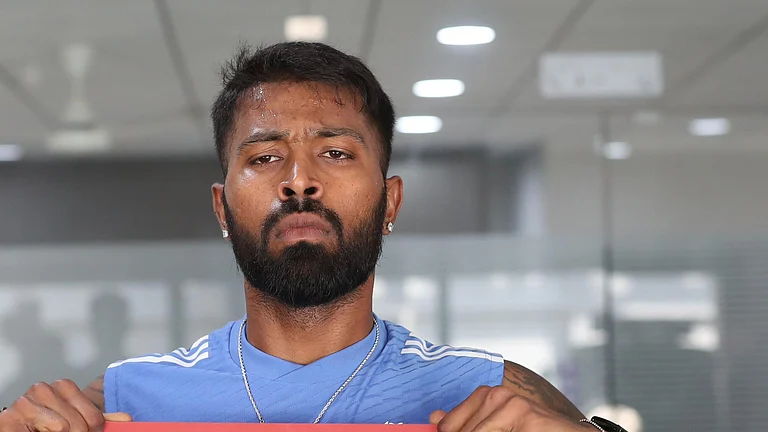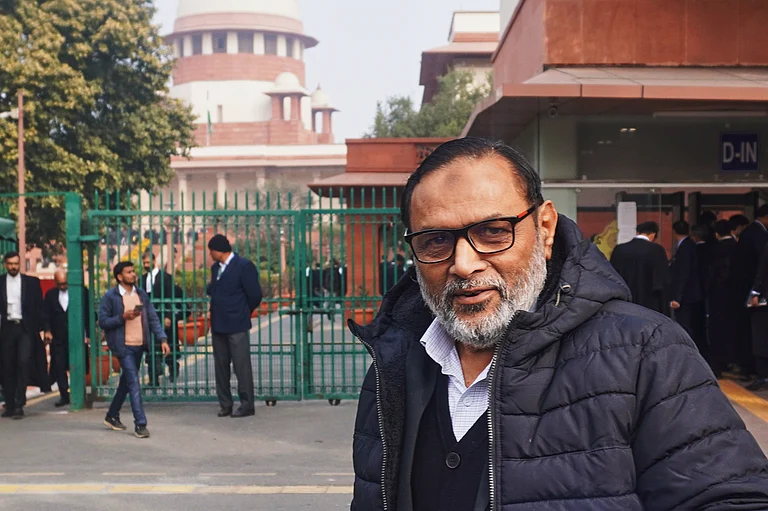Krishnakumar is busy with multiple responsibilities in his new avatar as a ‘comrade’. Apart from his busy schedule as a member of the CPI(M) at the local level, he has to also perform his duty as the state committee member of the Shopper’s Union of the Centre of Indian Trade Unions (CITU) and the district level member of the Rehabilitation and Palliative Care in Pathanamthitta run by the CPI(M).
But for over 40 years of his life, he was an ardent supporter of the Rashtriya Swayamsevak Sangh (RSS) and an active worker of the BJP. Krishnakumar had been the district committee member of the BJP till 2020. He was also the organiser of the first-ever public protest against the Supreme Court verdict approving the entry of women of menstruating age in the Sabarimala temple.
In 2021, Krishnakumar quit the BJP and cut off his relationship with the RSS. He joined the CPI(M). Now he regrets his belief that women of menstruating age should not enter the Sabarimala temple. “I am ashamed. I regret it. Menstruation is very much a natural thing. Discriminating against women for having a natural body process is inhuman,” he says.
Krishnakumar recollects the memories of 2018, the year in which Kerala witnessed two major disasters—the floods and the communal polarisation that unleashed aggressive street protests. “The Sabarimala protest will be a black spot in the history of Kerala. There are genuine devotees who were hurt by the Supreme Court’s verdict. They were misled by the Sangh Parivar and had become puppets in their political game,” says Krishnakumar.
Krishnakumar lives in Pandalam, a small town in Kerala which has a mythological relationship with the Sabarimala temple—one of the most popular pilgrim centres in South India. The story of Pandalam Palace is entwined with that of the temple. According to a local legend, the divinity of Sabarimala was discovered by the King of the Pandalam dynasty between the 12th and the 13th century and the temple was constructed by them. The sacred jewellery of the deity is kept at a local temple (Valiya Koyikkal) at Pandalam under the custody of the Pandalam Palace. Every year, as part of the Makaravilakku festival, members of the Pandalam Palace retrieve the revered jewellery from the local temple and embark on a public procession to the Sabarimala temple to adorn it on the deity.
For Krishnakumar, who lives near the Palace, the memories of a lifetime are closely attached with the Palace and the Sabarimala temple. “We all were anxiously waiting for the verdict. I was against the idea of women of menstruating age entering the temple, but the RSS and the BJP were in support of women’s entry till the day the Supreme Court verdict came out,” says Krishnakumar.
On the day of the verdict, the members of the Pandalam royal family called for a small meeting of the family members and a few others close to the Palace. Krishnakumar was one of them. The Palace members decided to organise a prayer meeting. “There was no decision for a protest. There was a very clear instruction from the Palace that it was only a prayer meeting and there would be no slogans or any kind of gesture—neither against the government nor against the court. We expected 20-30 people, but more than 100 people participated,” claims Krishnakumar.
However, this “positive response” inspired the Palace members to organise a bigger rally and prayer meeting on October 2, 2018. A 13-member committee was formed, called the ‘Ayyappa Dharma Samrakshana Samithi’, and chaired by Krishnakumar. “We had only two days to spread the message and we were expecting a crowd of 5,000-10,000 people,” says Krishnakumar. But what Kerala witnessed on that day was beyond everyone’s expectations.

According to the organisers, not less than 65,000 people gathered in Pandalam town. The members of the Palace who had a cordial relationship with the government and the ruling CPI(M) did not want to go into a protest mode. “There was a strict instruction not to carry flags of any of the organisations. We were also instructed not to raise slogans, but only chant prayers,” Krishnakumar says, affirming that neither he nor the Palace members had any political agenda behind organising the rally. However, nobody including the Palace members and the organisers expected such a massive participation in the rally. Even the women belonging to the Left parties, participated in the rally, according to the organisers.
Reshmi Krishnan, the former councillor of Pandalam Municipality and a member of CPI(M) was hurt by the decision to open the temple to all women. Despite being a member of the CPI(M), she believes that women of menstruating age should not enter the temple. As she is a member of the CPI(M), Reshmi could not participate in the prayer rally, but she did what she could. “There was a call on WhatsApp to protest by lightning lamps at home and on the road. I did that,” she says. Reshmi disagrees with the Left Front Government’s policy of favouring women entering Sabarimala. However, she lost the Municipal elections in 2020.
The dominant narrative established by the Sangh Parivar organisations in Kerala is that the rally was organised “by nobody” but it “happened and evolved organically”. “It was organised by Lord Ayyappa,” says Prithwipal, a dedicated member of the RSS who played a vital role in the Sabarimala protest. He also said that by no stretch of the imagination did he expect such massive participation.
Interestingly, nobody was against the entry of young women in Sabarimala till the day of the judgment, including the RSS. Political parties too, including the BJP and the Congress, welcomed the judgment as a milestone towards the goal of gender equality. Janma Bhumi, the mouthpiece of the BJP, carried an article on the editorial page welcoming the judgment. The article was written by R Sanjayan, the then Deputy Director of Bharateeya Vichara Kendram, the think-tank of the Sangh Parivar in Kerala.
The overwhelming response to the prayer rally forced the BJP to change its stand overnight. “The party decided to reap the fruits of it and thus played the worst political game that created deep divides in Kerala’s society,” says Krishnakumar.
“The RSS formally supported the entry of women in Sabarimala, but there was a conflict within the organisation. A majority of the leaders were in support, but a few were against it,” says Krishnakumar, who belonged to the minority in the RSS who were against the entry of women.
The prayer rally and the public meeting in Pandalam sparked a communally-volatile atmosphere. Later, violence led to clashes between the devotees and the police. Women were attacked and were forced to show their identity cards to prove their age even on the roads to Pampa, the town located on the foothills of Sabarimala. It created a communal atmosphere in Kerala, marked by fervent opposition to the Supreme Court judgment. Even women journalists representing national and international media were manhandled. Kerala witnessed the violent manifestation of aggressive misogyny on the streets that lasted for three months. Hundreds of men and women came out of their homes and joined the protest all across Kerala against ‘violating customs and destroying the sanctity of the sacred temple’ by letting young women go to the sanctum sanctorum.
The Sangh Narrative
What forced hundreds of devotees to come out on the streets and opt for violent resistance against the implementation of the Supreme Court verdict? It was not just an impulsive and emotional reaction to the Supreme Court judgment. It was the culmination of the ‘phobia’ of ‘Sabarimala being consistently targeted’ that evolved over the decades. This fear of an unknown enemy conspiring to destroy Sabarimala has been engineered by the Sangh Parivar. A conversation with Prithwipal, the local leader of the RSS who has been at the forefront of the protest, validates this argument.
“The attempt to open Sabarimala temple to all women irrespective of their age is only the latest one in a series of deliberate efforts to destroy Sabarimala,” says Prithwipal. He argues that there is an international conspiracy against Sabarimala. Constant efforts have been made to sabotage the temple since 1950. On June 14, 1950, the temple and its premises were destroyed in a ‘mysterious fire’. “That was the beginning. Who set fire to the temple? Why did the police fail to find the criminals? Prithwipal does not hide what he feels. According to him, there was a “Christian conspiracy” behind the incident. “It was done by a prominent Christian family, but the culprits are at large,” says Prithwipal. Another incident in ‘this series’ is the attempt to establish a Catholic Church at Nilakkal, 20 km away from the temple. In 1982, a stone cross was claimed to have been found at Nilakkal. A section of the Catholic priests claimed that a church built by St Thomas, the disciple of Jesus Christ, had existed there centuries ago. The then Congress-led UDF Government had approved a plan to construct a church in that locality. The Sangh Parivar organisations strongly objected and launched an agitation. The protest they organised in 2018 was similar to the 1982 agitation.
The entry of Kannada actor Jayamala in the temple was yet another incident in the Sangh’s narrative of the conspiracy against Sabarimala. In 2006, she stirred up a huge controversy by ‘confessing’ that she had entered the temple at the age of 27 along with her husband and touched the deity. “Who sent her? Who was playing behind her and what was their agenda?” asks Prithwipal. (Interestingly, Jayamala was a minister in the previous BJP government in Karnataka).
Prithwipal argues that the proposal to construct an airport at Nilakkal is also a part of an international Christian conspiracy to destroy Sabarimala. “The devotees do not want to fly. The very idea of pilgrimage is to take the hardships of trekking all the way to the top of the hill to reach the sanctum sanctorum. The funding for this airport comes from America,” says Prithwipal.
The RSS has successfully created the narrative of an international conspiracy of consistent efforts to destroy and capture Sabarimala. The decision to open the temple to women of menstruating age is the latest, says the RSS. The Sangh Parivar says that the protest was due to people’s fear of ‘violating customs’. But they also believe that people fear an unknown enemy who has been consistently conspiring to destroy the temple over decades.
The 2018 Sabarimala protest organised by the BJP and their umbrella organisations was one of the worst experiments in mobilising emotions for political gains in the history of Kerala. “We cannot say whether the secular society could successfully engage with this attempt made by the Sangh. As there are no black and white solutions; success is not tangible and cannot be measured now. Only time will tell,” says Sunil P Ilayidam, a professor at Kalady University and a prominent voice against communal polarisation in the name of Sabarimala.
(This appeared in the print as he 'Polarity of Sabarimala')


























